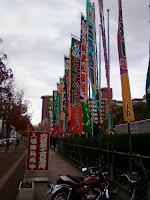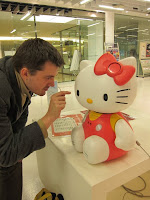Waking up in our well furnished, but not-quite-large-enough-for-four-people hotel room I endeavoured to have the shower that I was sorely missing having not had a chance to do so in the Net Cafe. They had showers there, but I stupidly put my phone on silent meaning I overslept by 20 minutes whilst the vibrations from the phone frantically told me to get out of bed. Being a white western man, I consider shower time to be an entirely private affair; you go in and take a shower alone. This is not the case with the Japanese; family members often wash each other’s backs before taking a shower, and as in this case, sometimes girls will barge in whilst you are standing, naked as the day you were born, desperately clinging to the shower curtain in order to provide a modicum of protection, and insist that there’s no time to wait for you to finish. With my trauma still fresh in my memory, we left to hotel and travelled to our raison de voyage; the final day of the Fukuoka Basho - the grand sumo tournament.
The outside of the venue was decorated in all manner of colourful flags, each with the name of one of the more well-known of the wrestlers emblazoned on them. My friends and I had a box seat whilst the girl who performed shower interuptus on me had splashed out for a ringside seat. A box seat at sumo largely consists of four cushions with enough space for you to sit and have a picnic/build a fort/put on a gymnastics show. Generally speaking, they are the medium priced seats, coming in at 10,000 yen per day, the ringside seats costing 15,000 yen and the seats at the back 5000 yen. We got there quite early, only a small handful of people came to watch, as tournaments are set up so the the lowest ranked and least famous fight first and the wrestlers get increasingly more prestigious until the last match in which the grand champion fights.
It took me a little while to figure out what was going on, but I eventually got the gist of it. First the name caller (so called because he calls people’s names) comes on stage and sings on the names of the wrestlers in a high pitched, nasal drone. The wrestlers then enter the ring and start their warm-up dance. First they point to the sky, put their hands on their knees and crouch down. Then keeping the knees bent at the same angle they lift one leg up in the air as high as they can and bring it down on the ground in a stomping motion, repeating the process for the other leg. The wrestlers then crouch down, touch the ground with their knuckles and promptly stand up to repeat the process again, the higher-ups also leave the ring to throw salt on it. This whole process took up most of the day I spent watching sumo, and considering most matches only last a few seconds, the result ends up being that there is a huge build-up of tension. The fact that the match takes a lot less time than the very ritualised build-up must be why the Japanese take sumo so seriously, because the actual fighting comical to the point of being farcical.
Sumo consists of two overweight men slapping each other’s jelly rolls and trying to make them either fall over or step out of the ring. Since they’re are not allowed to strike with the fist, the matches often resemble a cross between a cat-fight outside an Essex nightclub at 2.00am and the fight scene between Hugh Grant and Colin Firth in Bridget Jones’ Diary. However, as the day wore on something changed. I don’t know whether it was the alcohol, the over-exposure or the hypnotising effect of jiggling blubber, but I began to find sumo less ridiculous. It probably helped as well that by the end of the day the fighters were of a higher quality, but sumo was starting to make sense. There are no weight classes in sumo, so wresters are almost forced to be as heavy as they can to survive, and there was real skill and technique being displayed by the wrestlers.
 |
| Aran...I think |
The day ended in a hour long party with the sumo wrestlers, of which about half was taken up with a long presentation during which I drank all the wine I was suppose to save for the toast. An unfortunate miscalculation meant that by the time we arrived at the station to get the bullet train, we had only 10 minutes to find the platform, buy all the souvenirs and board the train. So I transformed into super present buying mode and managed to accomplish all my goals within 5 minutes, although many Fukuokans were no doubt entertained by the sight of me desperately grabbing things from the shelves like a forgetful parent on Christmas Eve. If you are considering coming to Japan to watch the sumo, then I highly recommend bringing alcohol with you, repetitive, ridiculous and yet highly entertaining...as long as you’re just a little bit drunk.








